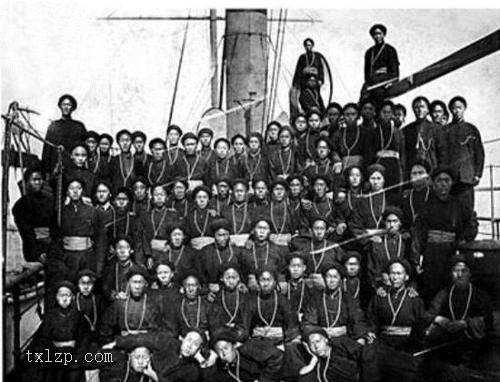Period:Tang dynasty Production date:728 (Date recorded for the death of general Liu Tingxun.)
Materials:earthenware
Technique:glazed
Subjects:mammal
Dimensions:Height: 33 inches
Description:
‘Sancai’ (three-colour) ceramic tomb figure of a camel. The saddlebag clearly shows a ‘monster’ mask, perhaps to frighten off danger. Made of brown, green glazed earthenware.
IMG
![图片[1]-figure BM-1936-1012.228-China Archive](https://chinaarchive.net/Tang dynasty/43/mid_00299655_001.jpg)
![图片[2]-figure BM-1936-1012.228-China Archive](https://chinaarchive.net/Tang dynasty/43/mid_00602651_001.jpg)
![图片[3]-figure BM-1936-1012.228-China Archive](https://chinaarchive.net/Tang dynasty/43/mid_00020961_001.jpg)
![图片[4]-figure BM-1936-1012.228-China Archive](https://chinaarchive.net/Tang dynasty/43/mid_Sancai_tomb_figures.jpg)
![图片[5]-figure BM-1936-1012.228-China Archive](https://chinaarchive.net/Tang dynasty/43/mid_00596792_001.jpg)
![图片[6]-figure BM-1936-1012.228-China Archive](https://chinaarchive.net/Tang dynasty/43/mid_00585139_001.jpg)
![图片[7]-figure BM-1936-1012.228-China Archive](https://chinaarchive.net/Tang dynasty/43/mid_00596798_001.jpg)
![图片[8]-figure BM-1936-1012.228-China Archive](https://chinaarchive.net/Tang dynasty/43/mid_00020962_001.jpg)
![图片[9]-figure BM-1936-1012.228-China Archive](https://chinaarchive.net/Tang dynasty/43/mid_00035356_001.jpg)
![图片[10]-figure BM-1936-1012.228-China Archive](https://chinaarchive.net/Tang dynasty/43/mid_00602653_001.jpg)
![图片[11]-figure BM-1936-1012.228-China Archive](https://chinaarchive.net/Tang dynasty/43/mid_PS219015_Grey.jpg)
![图片[12]-figure BM-1936-1012.228-China Archive](https://chinaarchive.net/Tang dynasty/43/mid_PS219015_Graduated.jpg)
![图片[13]-figure BM-1936-1012.228-China Archive](https://chinaarchive.net/Tang dynasty/43/mid_PS219015_1055.jpg)
![图片[14]-figure BM-1936-1012.228-China Archive](https://chinaarchive.net/Tang dynasty/43/mid_RRC9689.jpg)
Comments:Michaelson 2006:This camel is part of a group of thirteen tomb figures said to have come from the tomb of a general who died in AD 728 and was buried at Luoyang. The use of ‘sancai’ wares in the north was subject to social restrictions, so the discovery of glazed figures in a tomb is a clear sign of the status of both the ceramics and the deceased. Earthenware figures formed part of the funerary procession and were displayed on carts, the number and size of the figures determined by the rank of the deceased. The figures were moved into the tomb after the coffin was placed inside the burial chamber.The camel’s humps are laden with the types of goods, including a pitcher for carrying liquid and some meat for the journey, that they would have carried over the Silk Route, which was at its height during the Tang dynasty – one of the most cosmopolitan periods in Chinese history. The resilient and cantankerous Bactrian camels plied these difficult trade routes across vast expanses of inhospitable terrain, carrying up to 120 kg of cargo. China exported luxuries such as silk, lacquer ware, bamboo products and steel and imported perfumes, horses and jewels from the Western world. This figure and the others in this group are said to be from the tomb of Liu Tingxun on the basis of an article in ‘The Burlington Magazine’ (January 1921) written by R.L. Hobson. At that time the figures were on loan to the V&A Museum. In this illustrated essay Hobson states that a rubbing of the epitaph tablet from the tomb of Liu Tingxun “followed the figures to this country”. It was translated by Arthur Waley and is quoted in the article. The location of this epitaph rubbing is unknown.
Materials:earthenware
Technique:glazed
Subjects:mammal
Dimensions:Height: 33 inches
Description:
‘Sancai’ (three-colour) ceramic tomb figure of a camel. The saddlebag clearly shows a ‘monster’ mask, perhaps to frighten off danger. Made of brown, green glazed earthenware.
IMG
![图片[1]-figure BM-1936-1012.228-China Archive](https://chinaarchive.net/Tang dynasty/43/mid_00299655_001.jpg)
![图片[2]-figure BM-1936-1012.228-China Archive](https://chinaarchive.net/Tang dynasty/43/mid_00602651_001.jpg)
![图片[3]-figure BM-1936-1012.228-China Archive](https://chinaarchive.net/Tang dynasty/43/mid_00020961_001.jpg)
![图片[4]-figure BM-1936-1012.228-China Archive](https://chinaarchive.net/Tang dynasty/43/mid_Sancai_tomb_figures.jpg)
![图片[5]-figure BM-1936-1012.228-China Archive](https://chinaarchive.net/Tang dynasty/43/mid_00596792_001.jpg)
![图片[6]-figure BM-1936-1012.228-China Archive](https://chinaarchive.net/Tang dynasty/43/mid_00585139_001.jpg)
![图片[7]-figure BM-1936-1012.228-China Archive](https://chinaarchive.net/Tang dynasty/43/mid_00596798_001.jpg)
![图片[8]-figure BM-1936-1012.228-China Archive](https://chinaarchive.net/Tang dynasty/43/mid_00020962_001.jpg)
![图片[9]-figure BM-1936-1012.228-China Archive](https://chinaarchive.net/Tang dynasty/43/mid_00035356_001.jpg)
![图片[10]-figure BM-1936-1012.228-China Archive](https://chinaarchive.net/Tang dynasty/43/mid_00602653_001.jpg)
![图片[11]-figure BM-1936-1012.228-China Archive](https://chinaarchive.net/Tang dynasty/43/mid_PS219015_Grey.jpg)
![图片[12]-figure BM-1936-1012.228-China Archive](https://chinaarchive.net/Tang dynasty/43/mid_PS219015_Graduated.jpg)
![图片[13]-figure BM-1936-1012.228-China Archive](https://chinaarchive.net/Tang dynasty/43/mid_PS219015_1055.jpg)
![图片[14]-figure BM-1936-1012.228-China Archive](https://chinaarchive.net/Tang dynasty/43/mid_RRC9689.jpg)
Comments:Michaelson 2006:This camel is part of a group of thirteen tomb figures said to have come from the tomb of a general who died in AD 728 and was buried at Luoyang. The use of ‘sancai’ wares in the north was subject to social restrictions, so the discovery of glazed figures in a tomb is a clear sign of the status of both the ceramics and the deceased. Earthenware figures formed part of the funerary procession and were displayed on carts, the number and size of the figures determined by the rank of the deceased. The figures were moved into the tomb after the coffin was placed inside the burial chamber.The camel’s humps are laden with the types of goods, including a pitcher for carrying liquid and some meat for the journey, that they would have carried over the Silk Route, which was at its height during the Tang dynasty – one of the most cosmopolitan periods in Chinese history. The resilient and cantankerous Bactrian camels plied these difficult trade routes across vast expanses of inhospitable terrain, carrying up to 120 kg of cargo. China exported luxuries such as silk, lacquer ware, bamboo products and steel and imported perfumes, horses and jewels from the Western world. This figure and the others in this group are said to be from the tomb of Liu Tingxun on the basis of an article in ‘The Burlington Magazine’ (January 1921) written by R.L. Hobson. At that time the figures were on loan to the V&A Museum. In this illustrated essay Hobson states that a rubbing of the epitaph tablet from the tomb of Liu Tingxun “followed the figures to this country”. It was translated by Arthur Waley and is quoted in the article. The location of this epitaph rubbing is unknown.
© Copyright
The copyright of the article belongs to the author, please keep the original link for reprinting.
THE END



![[Qing Dynasty] British female painter—Elizabeth Keith, using woodblock prints to record China from the late Qing Dynasty to the early Republic of China—1915-China Archive](https://chinaarchive.net/wp-content/uploads/2022/11/image-191x300.png)

